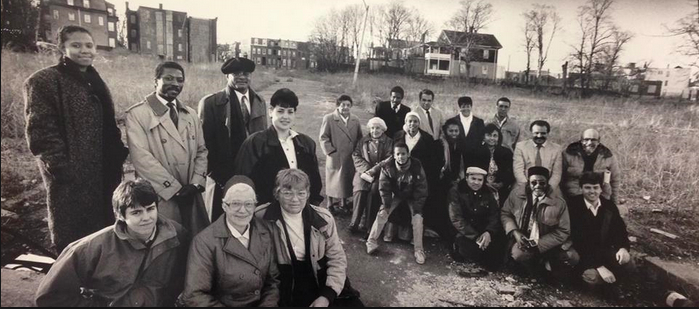The DSNI Model
The Dudley Street Neighborhood Initiative’s mission is to “empower Dudley residents to organize, plan for, create and control a vibrant, diverse and high quality neighborhood in collaboration with community partners.”
DSNI is a community organizing and community planning group. It is not a developer, not a social service provider. On the other hand, it is also not an ad hoc activist group focused on protesting against things, or on a single planning process. The DSNI model is, in a very real sense, an exercise in democracy, giving life to the notion that true power comes from the people.

In 1984, when DSNI was founded, failed urban policy and racist mortgage policies, including redlining, had devastated the community. Investment had fled, the poverty rate was very high, a huge number of lots were vacant and abandoned, and many residents felt angry and powerless. How those residents organized into DSNI and what they accomplished in their early years is documented in Holding Ground, the first film about DSNI, and in the book Streets of Hope by Peter Medoff and Holly Sklar.
The first years of DSNI made clear to the community the need to stay focused on their key goal — to raise the voice of the neighborhood and, in so doing, empower the residents to take control of their futures. That meant, they soon learned, that developing real-estate, running a land trust, and other tasks could distract from organizing and drain their energy. These needed to be delegated to others who had the expertise and capacity to do them, leaving DSNI free to continue to prioritize organizing and planning. And so, rather than becoming developers themselves, they put themselves in a position to hold the city and developers accountable.

The DSNI model organizes all the different people in the community—including youth, elders and all of the many ethnic groups—to be heard, to be active, and to lead. Formal leadership in the form of governance is determined by all community stakeholders: The organization’s board is chosen by community vote, with key constituencies represented by allotted seats.
DSNI has proven its institutional staying power over 30 years. Its commitment to facilitating and mobilizing community vision, decision-making, and action has allowed it to stay true to the community’s will. But, as many have observed before, democracy is messy. Over the years, less represented voices have had to assert themselves, most notably, young people. Early on, youth felt excluded and challenged the leadership to give them a place at the table—a seat they earned and received. As can be seen in Gaining Ground, many of these young people have grown to lead DSNI and have assumed leadership roles in Boston and in government.
As May Louie wrote of DSNI in Core Issues in Comprehensive Community-Building Initiatives: Exploring Race and Power, “It is a luxury, and yet a necessity, for a community to have an entity whose job is to organize and build this kind of capacity among residents, a function that neither community development corporations nor social service agencies can fulfill.”
In many ways, DSNI represents the stated aspirations of most community-based organizations that are trying to work comprehensively for change—showing tangible results while staying true to their democratic mission and their core constituencies.
For more on DSNI, see: http://www.dsni.org/news-events
For more on how this model shows up in the film, see the section of the viewer’s guide on the DSNI model and Working for Change.